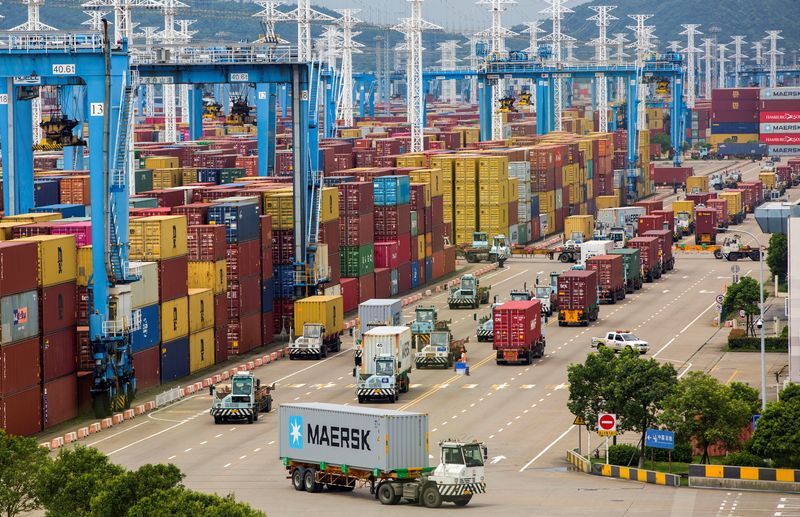BEIJING (Reuters) -China’s March exports contracted sharply, while imports also unexpectedly shrank, both undershooting market forecasts by big margins, customs data showed on Friday, highlighting the stiff task facing policymakers as they try to bolster a shaky economic recovery.
Shipments from China slumped 7.5% year-on-year last month, marking the biggest fall since August last year and compared with a 2.3% decline forecast in a Reuters poll of economists. They rose 7.1% in the January-February period.
“Besides disruptions from forex changes, the worse-than-expected momentum of both exports and imports in March indicate that more comprehensive and targeted policy stimulus will be needed for China to meet its ambitious growth target,” said Bruce Pang, chief economist at Jones Lang Lasalle (NYSE:JLL).
“It will be a long march for China’s foreign trade to again provide growth energy for the state.”
In the first quarter, exports showed a 1.5% year-on-year rise, according to the data.
The nation’s exporters endured a tough period for much of last year due to soft overseas demand and tight global monetary policy. With the Federal Reserve and other developed nations showing no urgency to cut interest rates, Chinese manufacturers may be faced with a further period of challenges as they try to shore up goods sales overseas.
The China Beige Book survey said the recent improvements in business conditions, including better corporate revenue, profits and capital spending, were “more of a return to mediocre from genuinely poor.”
Analysts warn Western concerns over China’s overcapacity in some industries may bring more trade barriers for the world’s manufacturing hub.
While overall exports weakened last month, steel shipments were at the highest level since July 2016.
Imports for March also declined 1.9% year-on-year from the 3.5% growth in the first two months, missing an expected 1.4% rise. For the first quarter, imports rose 1.5% year-on-year.
The imports figure underlined the sluggish domestic demand conditions, which were also highlighted by Thursday’s data showing consumer inflation had cooled more than expected last month.
March soybean imports fell to their lowest in four years while crude oil imports slipped 6%.
China’s economy got off to a relatively solid start this year after policymakers rolled out support measures to revive household consumption, private investment and market confidence since the second half of 2023.
Yet, growth in the Asian giant remains uneven and analysts don’t expect a full-blown revival anytime soon mainly due to a protracted property sector crisis.
Rating agency Fitch cut its outlook on China’s sovereign credit rating to negative on Wednesday, citing risks to public finances as the economy faces increasing uncertainty in its shift to new growth models.
The economy likely grew 4.6% in the first quarter from a year earlier – the slowest in a year despite signs of stabilisation, another Reuters poll showed on Thursday, maintaining pressure on policymakers to unveil more stimulus measures.
China last month set a full year growth target of around 5%, which analysts have described as ambitious as they noted that last year’s 5.2% expansion came off a COVID-hit 2022.
Some analysts say the central bank faces a challenge as more credit is flowing to production than into consumption, exposing structural flaws in the economy and reducing the effectiveness of its monetary policy tools.
On the fiscal front, China plans to issue 1 trillion yuan ($138.18 billion) in special ultra-long term treasury bonds to support key areas. It also raised the 2024 special bond issuance quota for local governments to 3.9 trillion yuan from 3.8 trillion yuan in 2023.

Moreover, in an attempt to revive demand, the cabinet last month approved a plan aimed at promoting large-scale equipment upgrades and sales of consumer goods. The head of the country’s economic planner estimated the plan could generate market demand of over 5 trillion yuan annually.
($1 = 7.2367 Chinese yuan renminbi)
To read the full article, Click Here

